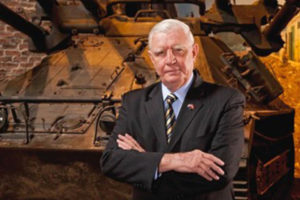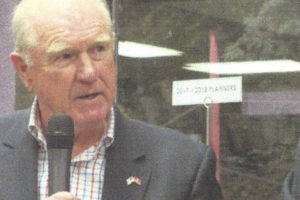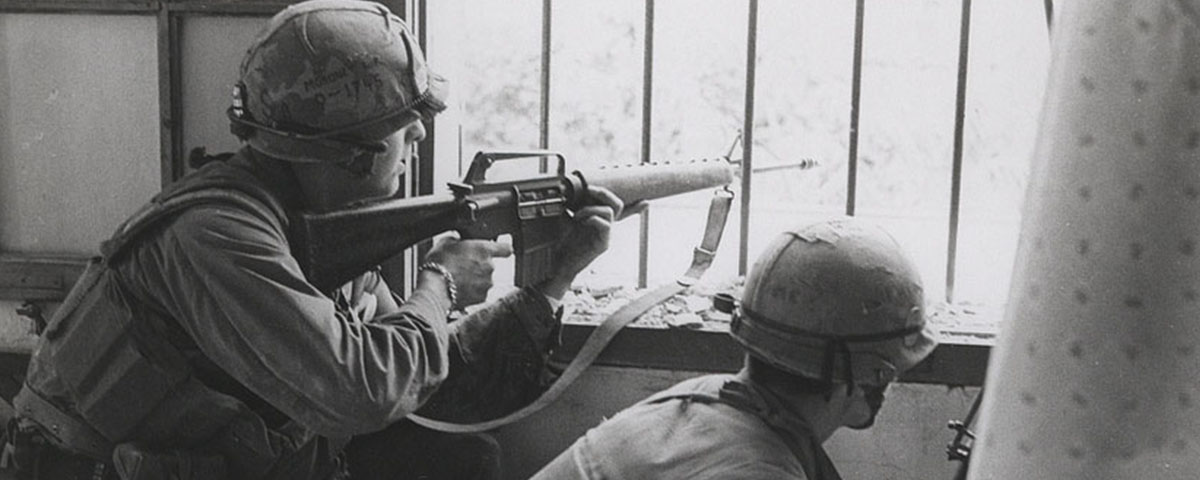The Battle of Hue has come to be regarded as one of the most infamous urban battles in Marine Corps history. The battle started during the communists’ Tet Offensive, when Marines were surprised by a North Vietnamese Army attack during what was supposed to be a cease-fire negotiated for a Vietnamese holiday. The battle started on Jan. 30, 1968, and didn’t end until March 3, 1968, for the Marines.
Retired Marines Lt. Gen. George “Ron” Christmas and Brig. Gen. Michael Downs, who were captains serving as infantry company commanding officers in Hue, spoke about their experiences in the battle to a group of staff noncommissioned officers during a Professional Military Education event at Marine Corps University at Marine Corps Base Quantico, Virginia, on March 27.
The event was planned to commemorate the 50th anniversary of the battle, and it also honored Vietnam Veterans Day, March 29. The two generals discussed not only the difficult fight, but also the lessons learned that can be beneficial to Marines today.

Christmas and Downs said Hue was unique because the Perfume River cut the city in half, and there were numerous other obstacles to navigate in the city, including moats and walls. Marine units were on the outskirts of the city to the south and west when they were attacked by the NVA on Jan. 30. At the same time, the city was infiltrated and attacked by division-size NVA and Viet Cong forces, leaving only two building compounds in the city held by the South Vietnamese Army and their American advisers.
As the Tet Offensive commenced, the Marines of Task Force X-ray—which included 1st Battalion, 1st Marine Regiment; 1st Battalion, 5th Marines Regiment; and 2d Battalion, 5th Marine Regiment located outside the city—fended off the fierce initial Tet attacks by the NVA and Viet Cong forces. However, it soon became clear that that the outnumbered Marines would be required to assist the South Vietnamese forces and their American advisers to take back the entire city of Hue, which had become overrun by the enemy.
The Marines who had to attack the city were at a disadvantage because they were inserted into the city piecemeal, had no real intelligence of the enemy’s strength and control over the city, and no air support or proper equipment available to them for initial days of the battle.
Christmas was leading Hotel Company, 2nd Battalion, 5th Marines, into Hue from the south. Since Vietnam was expected to be a jungle fight, Marines who fought in Hue had only one hour of training in urban combat. This is where their training to fight in “any clime and place” and their ability to adapt to and overcome situations proved essential.
In urban combat, “one of the things you’re supposed to do is isolate the city,” Christmas said. “Then, you need to select where you enter the city, then you can determine what you are going to use to take the city. None of that was available. The city was totally overrun, so we’re not about to isolate it because we don’t have the forces. We are going to have to fight our way in piecemeal and then gather up and retake the city from within.”
In another part of the city, where Downs’ Foxtrot Company, 2nd Battalion, 5th Marines, was flown in by helicopter, he was leading his men from building to building but had to use a bit of ingenuity and tear gas to do so. His company proceeded through the streets of Hue by blowing holes in the buildings with rocket-propelled grenades, referred to as RPGs, and then clearing them of the enemy with tear gas. “We would progress [through the city] in this way throughout the fight,” Downs said. The buildings provided at least some cover for the Marines as they fought their way down the streets of Hue.
In one instance, Christmas noted there was a machine gun directly down a street that his Marines needed to cross to advance their attack. While the captain was deciding how to approach this problem, a young lance corporal and a private first class approached him with an idea.
“I know how to do this,” said the lance corporal, according to Christmas. “Sir, I’ll roll my gun [a 106 mm recoilless rifle mounted on a four-wheeled mechanical mule] right out the door, fire it down the street. You know how big the round it. They’ll pull in their heads, and you can run the whole company across the street, concealed by the gun’s back blast if you want to.” When fired, the recoilless rifle put out a large discharge of gas, in the form of smoke, from the rear loading port that blew up much debris behind it.
Christmas liked the idea. The lance corporal and the private first class took the weapon into the streets and executed the plan while under heavy fire. It worked. “This is called lance corporal ingenuity and Pfc. power. It’s alive and well today and is in response to your leadership.”
Downs then told the staff NCOs gathered in the lecture hall that Marine ingenuity was showcased over and over in the battle to retake Hue. The Marines had to use the weapons that were available, and often they were used for other than their intended purpose.
For example, Army anti-aircraft vehicles called “Dusters” were used in the front and the back of a 12-truck convoy heading into Hue over the Perfume River Bridge because there were no tanks available. The Dusters did not have as much armor as a tank, but they were effective enough, and the convoy troops needed some type of protection since they were expecting an ambush.
People would say “that weapon isn’t for use in an urban environment. Forget that. If you can use the weapon to do what you need to do in the city, you use the weapon. It’s all up in here,” Christmas said, pointing to his head. “You know where those decisions come from? It comes from the noncommissioned officers.”
Urban battles are also known for close combat fighting.
“The enemy was 35 meters away, and we were launching RPGs and 3.5-inch rockets at each other,” Christmas said. As for our 81 mm and 60 mm mortars, “the enemy was so close to us that when the round went up, it went up so high that we thought it was going to come down right on top of us.”
Downs said: “Remember, an urban fight is a casualty-producing fight. It’s not just the round but all the debris that comes off of it.”
In any combat fight, there are going to be innocent civilian bystanders.
“This will differ by city; it will differ by what the enemy does,” Christmas said. “The enemy usually pulls them all together and tries to build a buffer.”
During the battle at Hue, most of the civilians hid out in buildings, according to Christmas. “But once you get them out you have to take them out the way you came in,” he said. “This could mean going through the same holes and breaches that you have been through. We walked them down the streets until they were out of the line of fire. You have to deal with it. You have to work out how to deal with it.”
“We take care of civilians,” added Downs.
Of course, with any firefight, there will be mistakes. Christmas said not a day that goes by that he doesn’t think about the mistakes he made during the battle. For example, he said that he had very effective snipers stationed on water towers. Unfortunately, he didn’t move them around to different places, and the NVA were able to locate them. They both were killed or wounded by the enemy.
“I live with that to this day,” Christmas said.
He added that it’s important for each Marine stay above the emotion of the fight.
“We’re all emotional. We care about our Marines,” Christmas said. “That young Marine of yours, that corporal who has always been the joy of

everybody and always has a joke, gets killed next to you. It’s pretty easy to get emotional, but what leaders get paid for is to stand above the emotion. It’s not easy. But if you can do that you will make the right decision. If you get emotional about it you won’t.”
Downs agreed that the emotional aspect of the fight is important and that he had his own way of dealing with the pain. He essentially made a memorial of each of his fallen Marines by keeping a book in which he wrote down the names and dates of all Marines killed and injured during the battle. It helps him remember them. He still keeps it in his possession and showed it to the NCOs.
“It is an enlisted man’s war in many respects,” Downs said. We had 30 personal decorations awarded to the company, and of the 30, 27 were enlisted with 24 being corporals and below.”
Both generals went back to Hue decades after the battle. Quantico Marines enrolled in Marine Corps University have also toured the city to learn from the history of the battle.
Downs said that Hue has been rebuilt since the battle; however, in some of the buildings still standing, the remnants of the fight remain. There are pock marks in exterior walls that were hit with machine gun fire and M16 bullets. But the city overall is beautiful.
“Whether you like it or not, you are all leaders and someday, one way or another, you will be involved in urban operations,” Christmas said. “The world is urban and that’s where you’re going to fight, and it’s up to you to ensure that you prepare yourself. Everybody will fight. Everybody is a rifleman. When you leave here, think about urban warfare and think about your contribution.”





